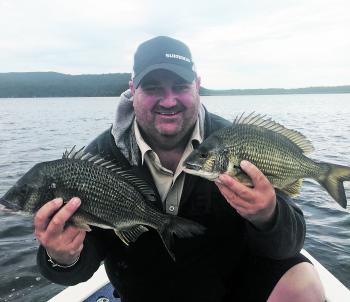Offshore anglers, particularly those fishing the bottom, have done extremely well with snapper, morwong and flathead making up most bags. The fish have been moving around a bit, so trying a number of locations until you find them has been the key to success. The reds have been close to shore with the cuttlefish run, with water depths of 15-20m being ideal.
I’d be concentrating north of Narooma with the close-in reef at Brou Beach holding a lot of snapper. The tide and current will determine whether you anchor or drift. Anchoring here seems to be best. Using a little berley with fresh pilchards or squid will work, as will soft plastics on occasion.
You can expect some solid models with fish to 5kg on the cards. Most will be pannies around 1.5-2kg – a great size for the plate. If the conditions are calm, you may have to go deeper. If this is the case, head a little further north and concentrate around Potato Point in 35-40m. This water depth always holds fish in winter and drifting is certainly the go.
If you’re after a feed of flatties, the 35-40m line straight off Dalmeny has been excellent, with some of the sandies pushing 60cm. That’s huge for this species. You don’t need many for a great feed. At Montague Island the kings have been up and down like a yo-yo – one day you get them and the next two, no joy. If you’re there on the good day, expect some awesome fishing.
Some of the kings are big with models pushing 16-18kg on the cards. These fish are usually an early morning proposition when they’re up on top smacking bait. The inside edge of the Fowl House Reef has been consistent. Slow trolling slimies or bigger deep divers will get the desired results.
If you get close enough to them when they’re on top, bigger style soft plastics or jigs will catch their fair share too. You won’t get heaps, but they will be big and awesome fun. If all that sounds too hard then jigging in 30 fathoms on the northern end of the island may get you a few fish. Whether they eat or not will depend a bit on tide and current. If the conditions suit, they will chew.
Further offshore, ‘tuna’ is the word. There’s a few of them. There has been a mixture of yellowfin and bluefin with the latter species being a long way offshore. I know of a few local boats that have travelled 60-70km to find the bluefin. The rewards justify the long distances travelled. Trolling has certainly been the method of choice, as you cover the miles to find the fish.
A mix of bibbless minnows and skirted pushers have worked. Every day is a little different. We should see the berley/bait brigade getting amongst it once the fish are found, especially fish in the 40-60kg bracket. We had a pretty short season last year on the tuna, so let’s hope this season is a little better.
In the estuaries, Wagonga Inlet has slowed up with the cool 15°C water. There are fish there, but you have to work for them. Anglers that are doing okay are fishing smaller soft plastics and blades in the deeper water (6-10m) and fishing them very slow. It can be like pulling teeth when this happens. When it’s cool, slow everything down, fish lighter leaders and gelspun and you will catch fish.
I’d be looking around the weeded margins while fishing artificials. The southern side of the inlet from Ringlands Point to the power lines upstream just before the four knot area is the place to fish. If this isn’t for you, then the lower sections in the channel should be good for trevally, bream and luderick. Both bait and lure casters will catch fish. The last three hours of the draining tide is best.
On the beaches the salmon numbers have certainly increased with the colder water. These supercharged bruisers are great fun in the suds on paternoster rigs fished with a bait/popper combination, or casting metal slugs on lighter gelspun outfits. It really doesn’t matter how you target them, you will catch them.
Most beaches are fishing well with Narooma main and Brou the standouts. If the salmon aren’t for you, then bream and winter whiting are on the cards. Both these species bite freely through winter and few anglers target them. You’ll find you don’t get huge numbers, but the quality of fish definitely increases. Look at beaches that have some sort of rocky formation nearby and fish quite shallow, just past the shore dump. Use with either live beach worms or pipis as bait.
Off the stones, it’s bread and butter time with drummer, luderick, bream and the odd groper all succumbing to fresh baits like cabbage, crabs or cunjevoi. Look for ledges that have a fair bit of white-water present and use a little berley. Don’t use too much, or the pickers will drive you nuts.
The better places to try include the golf course rocks, the southern breakwall on the incoming tide or Dalmeny Headland about 5km north. All these areas fish well during winter.
Reads: 2472
Your first mulloway on plastic is always a challenge, but it’s even more rewarding when it nearly hits the metre mark.

Dazza with some of the estuary dwellers that can be expected over coming weeks.




